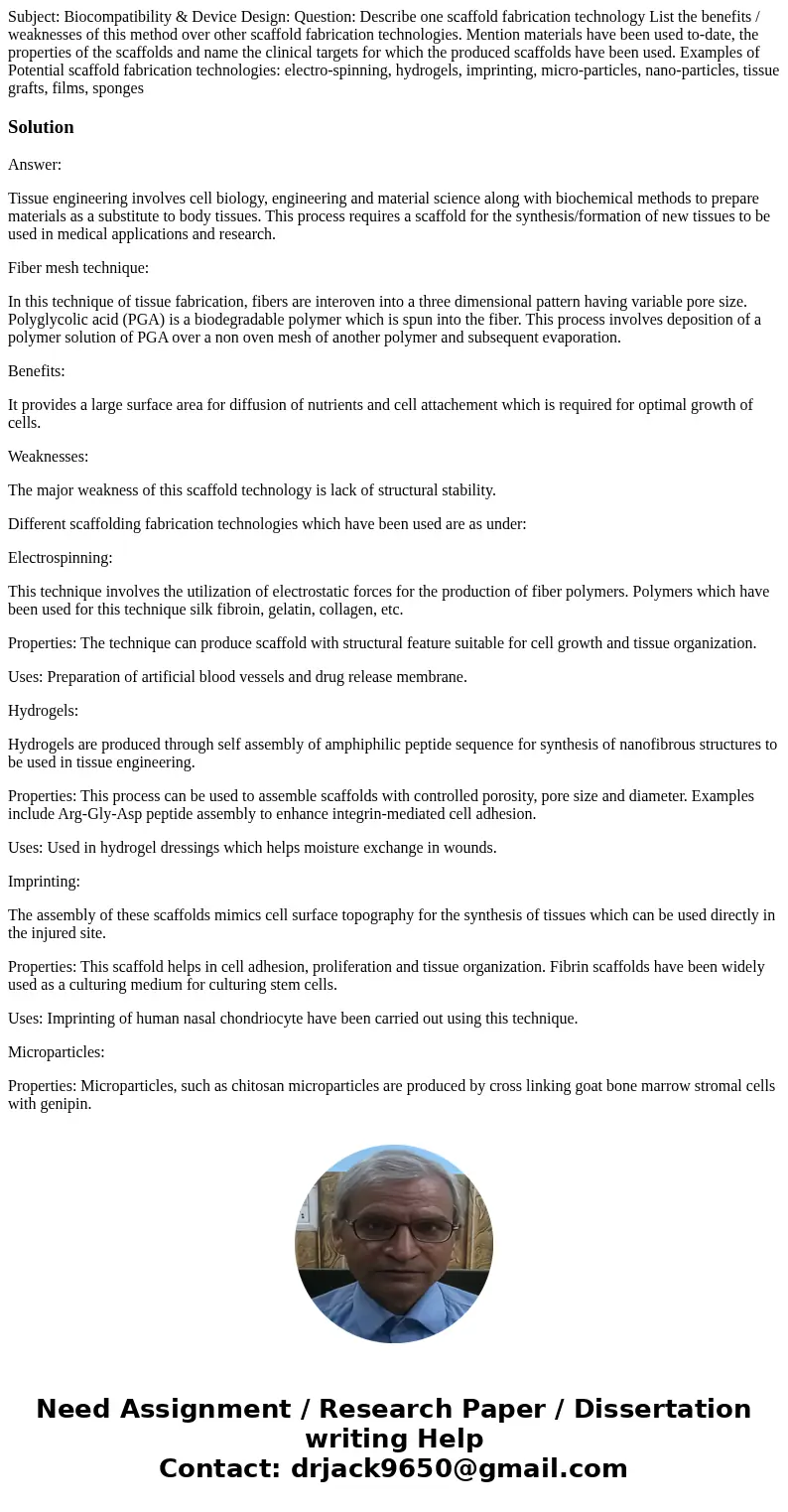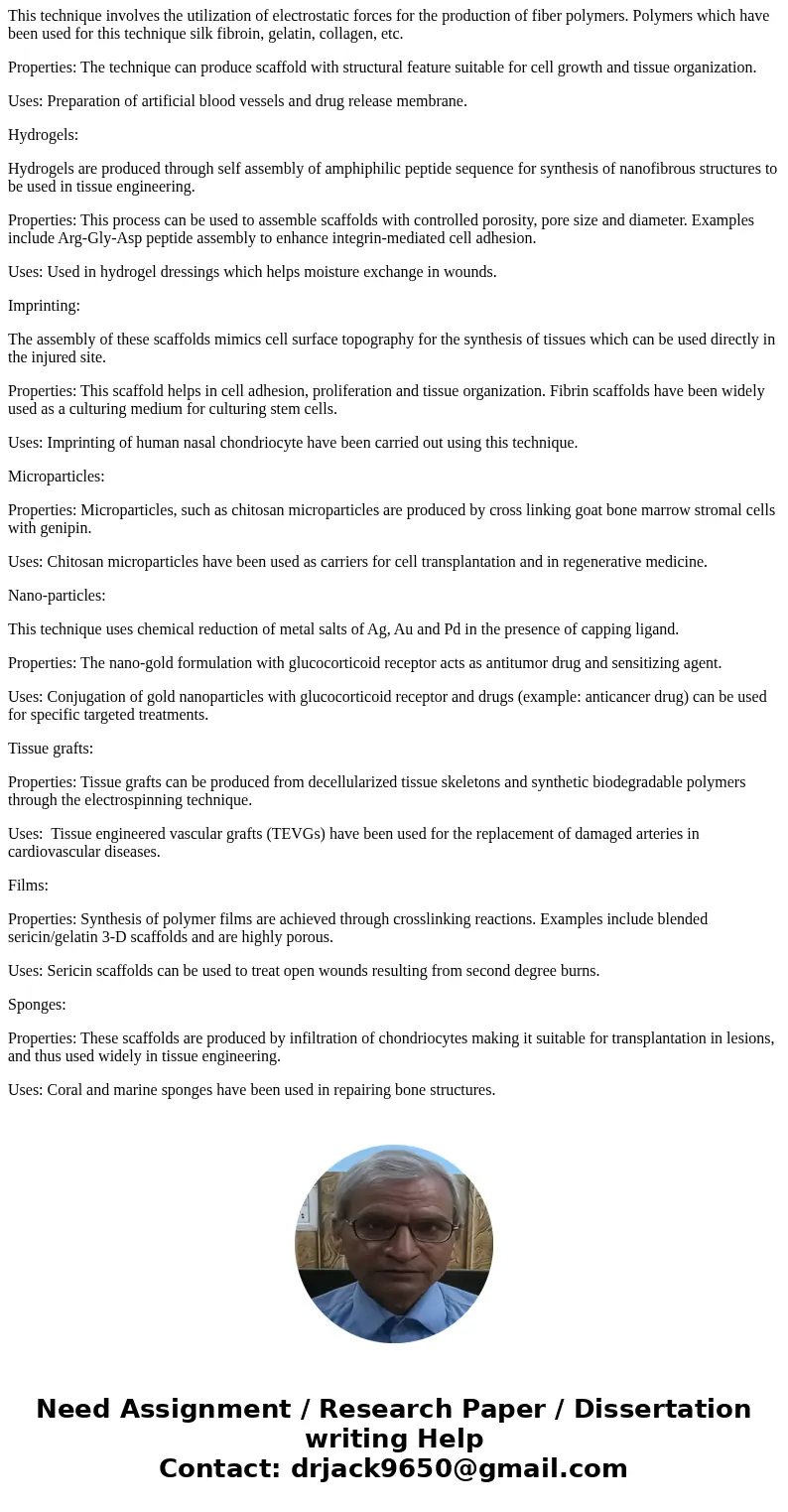Subject Biocompatibility Device Design Question Describe on
Subject: Biocompatibility & Device Design: Question: Describe one scaffold fabrication technology List the benefits / weaknesses of this method over other scaffold fabrication technologies. Mention materials have been used to-date, the properties of the scaffolds and name the clinical targets for which the produced scaffolds have been used. Examples of Potential scaffold fabrication technologies: electro-spinning, hydrogels, imprinting, micro-particles, nano-particles, tissue grafts, films, sponges
Solution
Answer:
Tissue engineering involves cell biology, engineering and material science along with biochemical methods to prepare materials as a substitute to body tissues. This process requires a scaffold for the synthesis/formation of new tissues to be used in medical applications and research.
Fiber mesh technique:
In this technique of tissue fabrication, fibers are interoven into a three dimensional pattern having variable pore size. Polyglycolic acid (PGA) is a biodegradable polymer which is spun into the fiber. This process involves deposition of a polymer solution of PGA over a non oven mesh of another polymer and subsequent evaporation.
Benefits:
It provides a large surface area for diffusion of nutrients and cell attachement which is required for optimal growth of cells.
Weaknesses:
The major weakness of this scaffold technology is lack of structural stability.
Different scaffolding fabrication technologies which have been used are as under:
Electrospinning:
This technique involves the utilization of electrostatic forces for the production of fiber polymers. Polymers which have been used for this technique silk fibroin, gelatin, collagen, etc.
Properties: The technique can produce scaffold with structural feature suitable for cell growth and tissue organization.
Uses: Preparation of artificial blood vessels and drug release membrane.
Hydrogels:
Hydrogels are produced through self assembly of amphiphilic peptide sequence for synthesis of nanofibrous structures to be used in tissue engineering.
Properties: This process can be used to assemble scaffolds with controlled porosity, pore size and diameter. Examples include Arg-Gly-Asp peptide assembly to enhance integrin-mediated cell adhesion.
Uses: Used in hydrogel dressings which helps moisture exchange in wounds.
Imprinting:
The assembly of these scaffolds mimics cell surface topography for the synthesis of tissues which can be used directly in the injured site.
Properties: This scaffold helps in cell adhesion, proliferation and tissue organization. Fibrin scaffolds have been widely used as a culturing medium for culturing stem cells.
Uses: Imprinting of human nasal chondriocyte have been carried out using this technique.
Microparticles:
Properties: Microparticles, such as chitosan microparticles are produced by cross linking goat bone marrow stromal cells with genipin.
Uses: Chitosan microparticles have been used as carriers for cell transplantation and in regenerative medicine.
Nano-particles:
This technique uses chemical reduction of metal salts of Ag, Au and Pd in the presence of capping ligand.
Properties: The nano-gold formulation with glucocorticoid receptor acts as antitumor drug and sensitizing agent.
Uses: Conjugation of gold nanoparticles with glucocorticoid receptor and drugs (example: anticancer drug) can be used for specific targeted treatments.
Tissue grafts:
Properties: Tissue grafts can be produced from decellularized tissue skeletons and synthetic biodegradable polymers through the electrospinning technique.
Uses: Tissue engineered vascular grafts (TEVGs) have been used for the replacement of damaged arteries in cardiovascular diseases.
Films:
Properties: Synthesis of polymer films are achieved through crosslinking reactions. Examples include blended sericin/gelatin 3-D scaffolds and are highly porous.
Uses: Sericin scaffolds can be used to treat open wounds resulting from second degree burns.
Sponges:
Properties: These scaffolds are produced by infiltration of chondriocytes making it suitable for transplantation in lesions, and thus used widely in tissue engineering.
Uses: Coral and marine sponges have been used in repairing bone structures.


 Homework Sourse
Homework Sourse